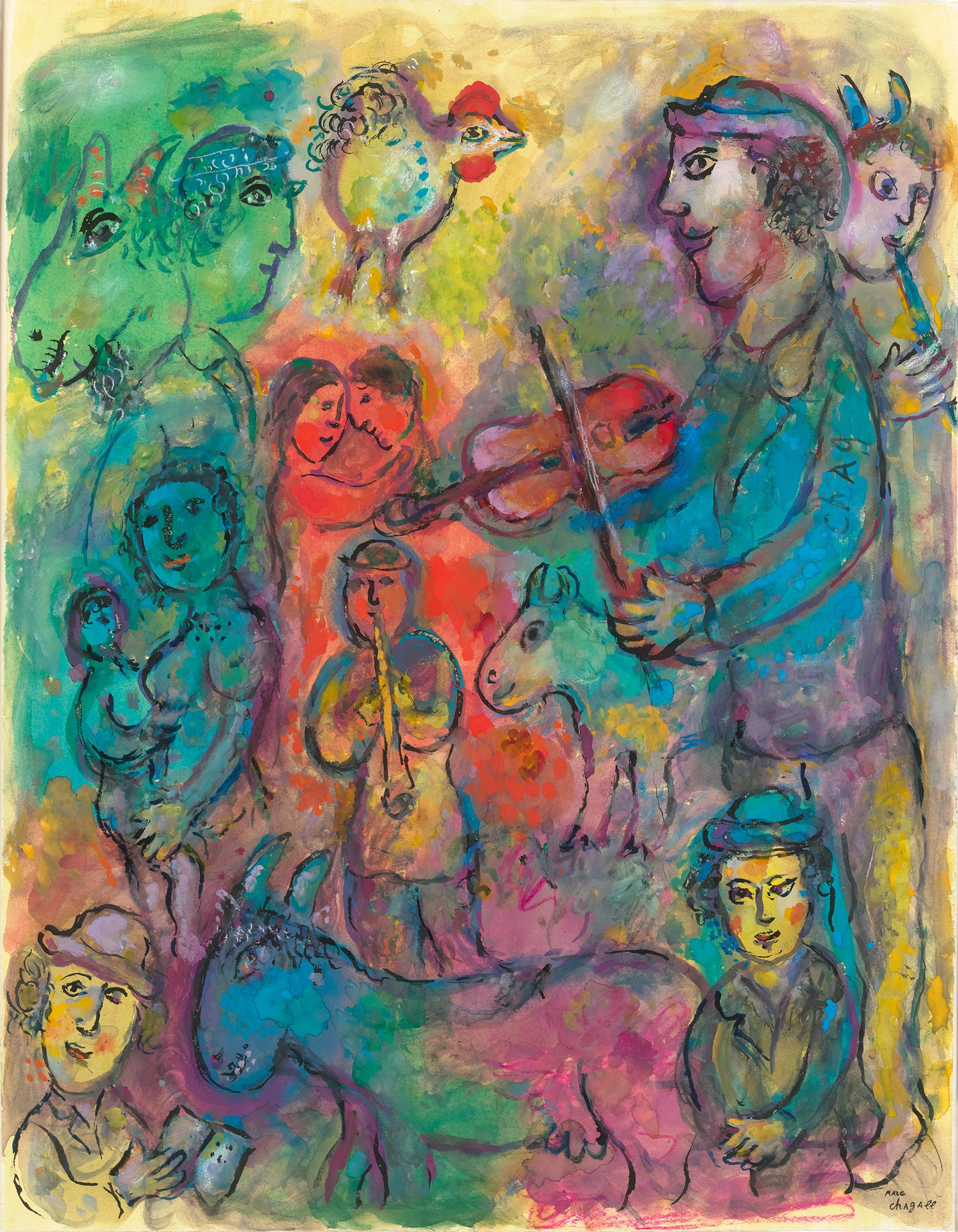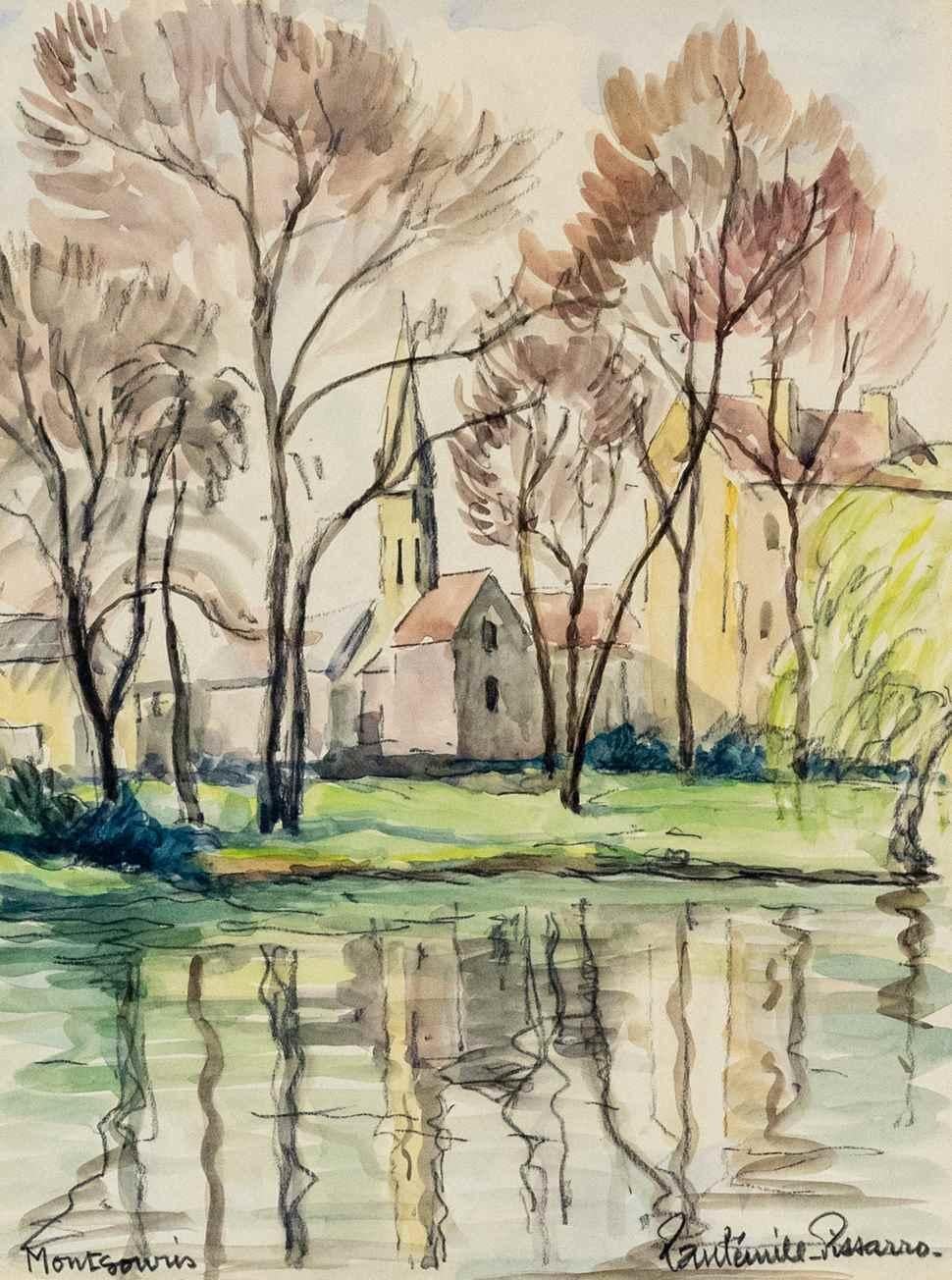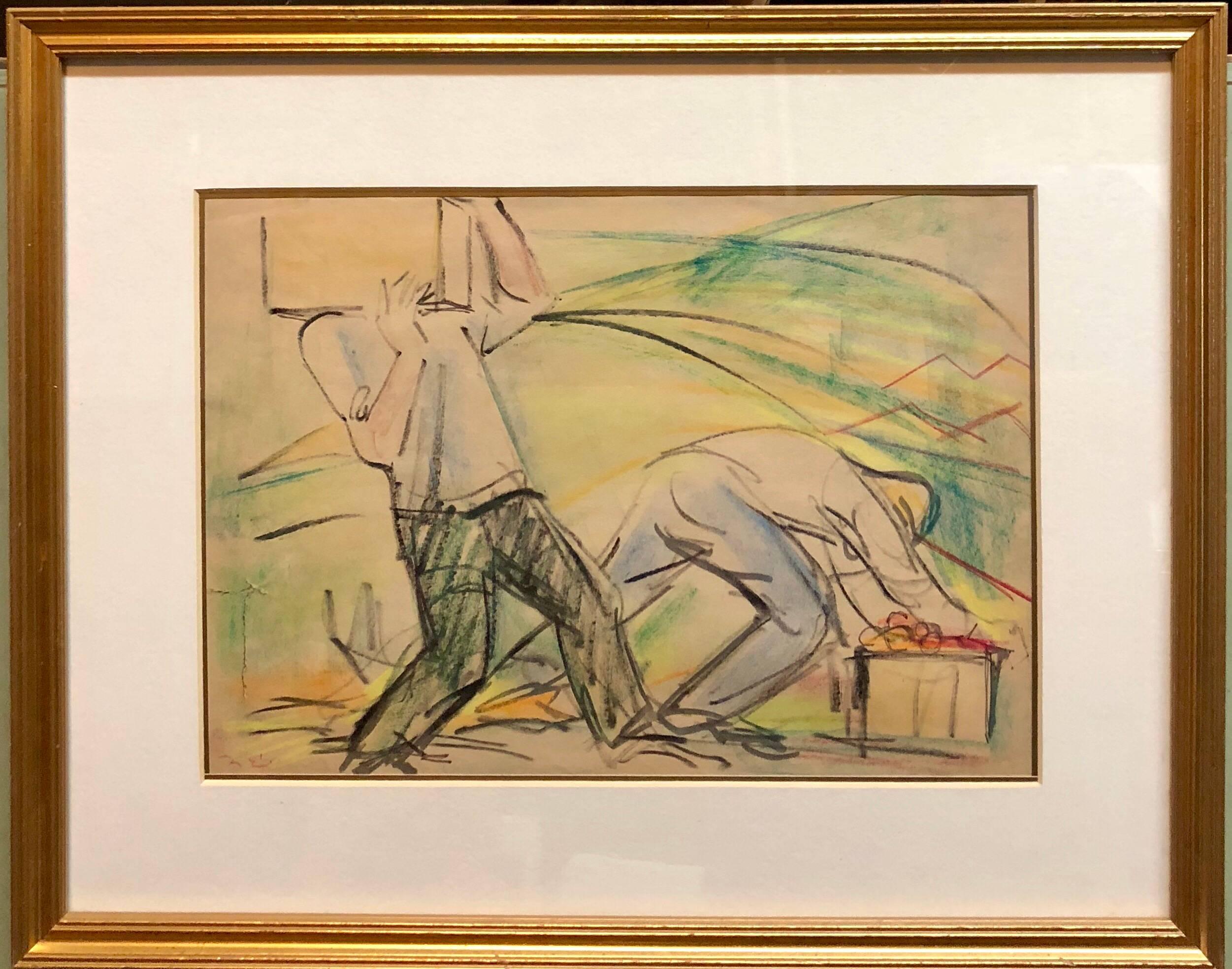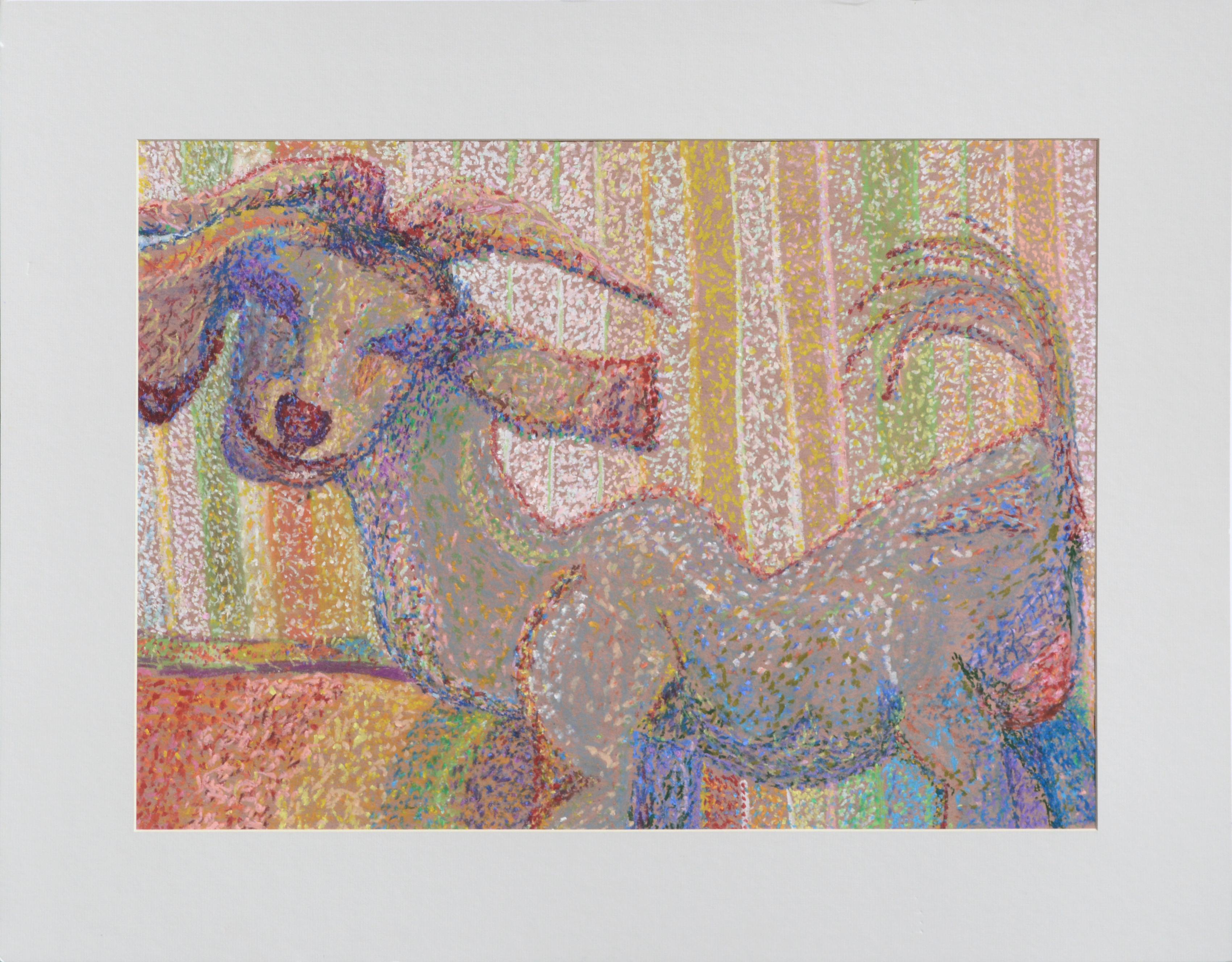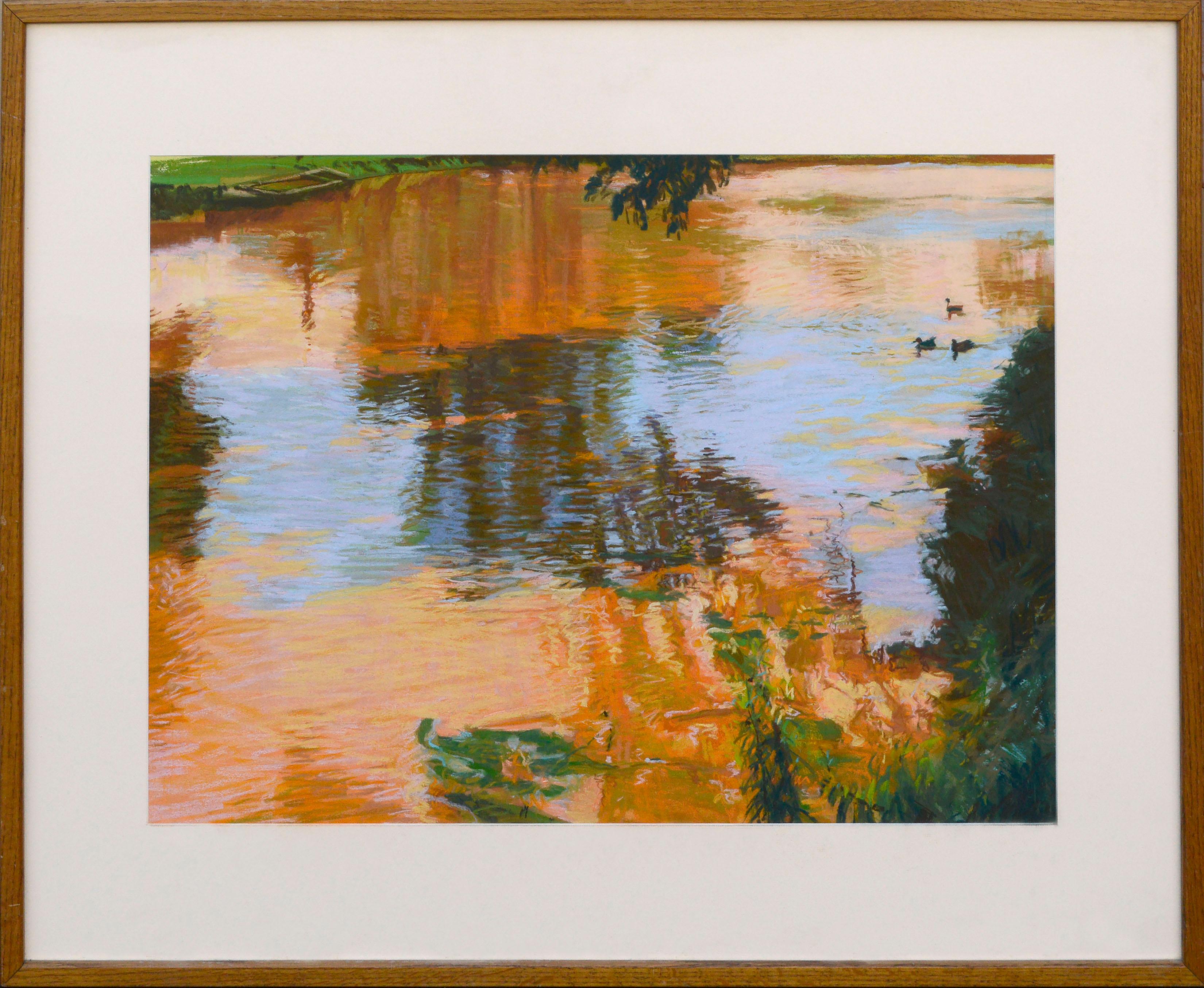Items Similar to Le Fondeur De Bronze By Lucien Lévy-Dhurmer
Want more images or videos?
Request additional images or videos from the seller
1 of 8
Lucien Levy-DhurmerLe Fondeur De Bronze By Lucien Lévy-DhurmerCirca 1906-1907
Circa 1906-1907
About the Item
Lucien Lévy-Dhurmer
1865-1953 French
Le fondeur de bronze
Signed "Levy Dhurmer" (lower right)
Pastel on paper
French painter Lucien Lévy-Dhurmer was one of the leading artists of the Symbolist and Art Nouveau movements at the turn of the century. This compelling portrait of men working in a bronze foundry bears witness to the artist’s skill for infusing his compositions with poignant imagery that honors the lives and labor of everyday people. Through a brilliant use of color and perspective, Lévy-Dhurmer's Le fondeur de bronze immerses the viewer in the intense heat of the foundry.
Lévy-Dhurmer's Le fondeur de bronze is further distinguished by prestigious provenance. The artwork's initial owner was Joseph Malesset, a French industrialist who made his fortune in owning industrial factories, including bronze foundries. Malesset was promoted to the revered grade of Officer of the Legion of Honor, the highest French order of merit, in 1906, and Lévy-Dhurmer's painting was created to glorify the visionary's achievements.
Born in French Algeria in 1865, Lucien Lévy-Dhurmer studied drawing and sculpture in Paris as a child and began his artistic career as a decorative painter at a porcelain manufactory in Golfe-Juan. Throughout his long career, Lévy-Dhurmer experimented with different artistic styles and mediums, succeeding as a ceramicist, painter, pastelist, and furniture designer. Perhaps his most celebrated work, the famed Wisteria Dining Room, now held in the Metropolitan Museum of Art, is a brilliant example of the artist’s remarkable range of skills in various media.
It was his trip to Italy in 1895 that would change the course of his life and interests. It was there that he discovered an interest in German and Florentine Renaissance — resulting in paintings that fit in well alongside those of the English Pre-Raphaelites. That same year, Lévy-Dhurmer officially began his painting career. In 1896, he held his first solo exhibition at the Galerie Georges Petit in Paris, where he appeared for the first time under the name Lévy-Dhurmer, adding to his surname Lévy part of his mother's maiden name, Pauline-Amelie Goldhurmer.
His unique blend of Academic detail with Impressionist color and technique garnered the artist considerable attention. He was drawn to the ideals of the Symbolist movement, which offered an intellectual alternative to the purely visual ideals of the Impressionists. Rather, the subject matter of the Symbolists explored more complex emotional and spiritual ideas - this highly personal portrait is a remarkable example of the movement's ethos.
Circa 1906-1907
Bears label on mount "Le fondeur de bronze / par Levy Dhurmer/ offert par ses amis à Monsieur J. MALESSET / Président de Section au Tribunal de Commerce de la Seine / à l'occasion de / Sa Nomination d'OFFICIER de la LEGION d'HONNEUR/10 février 1907"
Canvas: 34 3/4" high x 24" wide
Frame: 42 3/4" high x 33 3/8" wide x 2 1/2" deep
Provenance:Private Collection of Joseph Malesset
Private Collection, by descent from above
Private Collection, Basel, Switzerland
M.S. Rau, New Orleans
- Creator:Lucien Levy-Dhurmer (1865-1953, French)
- Creation Year:Circa 1906-1907
- Dimensions:Height: 42.75 in (108.59 cm)Width: 33.38 in (84.79 cm)Depth: 2.5 in (6.35 cm)
- Medium:
- Movement & Style:
- Period:
- Condition:
- Gallery Location:New Orleans, LA
- Reference Number:
About the Seller
5.0
Vetted Seller
These experienced sellers undergo a comprehensive evaluation by our team of in-house experts.
Established in 1912
1stDibs seller since 2013
13 sales on 1stDibs
Typical response time: 3 hours
- ShippingRetrieving quote...Ships From: New Orleans, LA
- Return PolicyThis item cannot be returned.
More From This SellerView All
- Musiciens Sur Fond Multicolore By Marc ChagallBy Marc ChagallLocated in New Orleans, LAMarc Chagall 1887-1985 Russian Musiciens sur fond multicolore (Musicians on a multicolored background) Signed 'Chag' (on the sleeve of the right figure); stamped with the signature 'Marc Chagall' (lower right) Tempera, gouache, colored ink and India ink and pastel on paper “The fact that I made use of cows, milkmaids, roosters and provincial Russian architecture as my source forms is because they are part of the environment from which I spring and which undoubtedly left the deepest impression on my visual memory of the experiences I have." - Marc Chagall Marc Chagall’s 1981...Category
20th Century Post-Impressionist Figurative Drawings and Watercolors
MaterialsPaper, Pastel, Ink, India Ink, Tempera, Gouache
- La femme préhistorique (Prehistoric Woman)By James Jacques Joseph TissotLocated in New Orleans, LAJames Tissot was among the most successful and critically acclaimed artists of the Victorian era. Although the artist is celebrated for his elegant scenes of fashionable life in Paris and London, this work is a fascinating rarity within his oeuvre. In this monumental pastel, Tissot depicts a prehistoric woman draped in a tiger skin, presented with a striking pose and heroic air. His delicate portraiture, combined with his fascination with conveying texture, demonstrates why he was one of the most revered artists of his generation, and La femme préhistorique illustrates the remarkable technique for which he was renowned. This work was completed in preparation for a series of works exploring the Old Testament undertaken by Tissot from 1899-1902 that remained unfinished at the time of his death. A portion of this series focused on illustrations of Adam and Eve, and among these sketches were images of a nude Eve partially draped in animal furs. Towards the end of his life, following his conversion to Catholicism, biblical subjects became important to the artist. A few years before this work was completed, Tissot embarked upon a highly ambitious group of nearly 300 watercolors illustrating the New Testament, presenting the illustrated epic in its entirety at the Paris Salon of 1894. Both of these series were a critical artistic departure for the artist, stemming from a desire to create works separated from his typical images of modern society. This pastel imagines Eve as the prototype of womanhood in the guise of a prehistoric woman. Tissot rarely painted the nude, and his skill as a draftsman highlights the figure's natural beauty, contrasting it with the stark landscape surrounding her. Although a study, this monumental work is incredibly well-finished and highly engaging, with the statuesque model commanding the majority of the canvas. Her pose is strong and theatrical, and she addresses the viewer with a direct, confident gaze. The imagined historical subject of this drawing is grounded by Tissot’s exceptional attention to detail. A master of conjuring an array of textures, Tissot showcased this ability in this work by juxtaposing many types of fabrics and natural elements within one composition. The tiger skin with which the woman partially covers herself was a favorite studio prop of Tissot’s, appearing in many of his most influential works from the period, including several paintings of his partner and favorite model Kathleen Newton. It, in particular, showcases the artist’s understanding of texture, yet it also serves as an exotic element that elevates the sensuality of the scene when placed against the woman’s bare skin. Born in 1836 in the port town of Nantes, Tissot traveled to Paris at the age of 20 in order to join the studios of Hippolyte Flandrin and Louis Lamothe. During this period, he became close with James Abbott McNeill Whistler, Edgar Degas and Edouard Manet, and the impact of these friendships is reflected in his portraits of modern life. Having enjoyed considerable success in Paris during the 1860s, Tissot fought in the Siege of Paris, and after the fall of the Commune in 1871, he went to London, where he stayed for the next ten years. He was met with incredible success there, and he also met the love of his life, Kathleen Newton, a divorcée, with whom he lived from about 1876 until her death in 1882. Today he is regarded among the great masters of Belle Époque painting, and his works can be found in important collections worldwide, including the Metropolitan Museum of Art, the Brooklyn Museum, the National Gallery of Art, the Musée d’Orsay, the Tate Gallery and many others. This pastel remained in Tissot's private collection until his death in 1902 and is referenced in the posthumous 1902-3 valuation of Tissot's home at 64 avenue du Bois...Category
Early 20th Century Academic Nude Drawings and Watercolors
MaterialsLaid Paper, Canvas, Oil Pastel, Pastel
- Portrait of a Mother and Child by Tsuguharu FoujitaBy Léonard Tsuguharu FoujitaLocated in New Orleans, LATsuguharu Foujita 1886-1968 | Japanese-French Portrait of a Mother and Child Signed “Foujita / Paris” (lower left) Ink and watercolor on paper An artistic luminary well ahead of his time, Tsuguharu Foujita burst onto the international art scene in the early 20th century as one of the most important artists in early Japanese modernism...Category
20th Century Post-Impressionist Portrait Drawings and Watercolors
MaterialsPaper, Ink, Watercolor
- Concours de Chiens au Promenade by Otto EerelmanBy Otto EerelmanLocated in New Orleans, LAOtto Eerelman 1839-1926 Dutch Concours de Chiens au Promenade Watercolor on paper Signed “O. Eerelman 1904” (lower left) A tour de force watercolor by celebrated Dutch artist Otto Eerelman, one of 19th-century Europe's most popular and important animal portraitists, this charming composition captures a bustling cross-section of fashionable elites walking their equally fashionable canine companions. Eerleman takes care to render the detailed attire of his subjects, complete with plumed hats and layers of lace trim. The artist paints the plethora of pets in equally painstaking detail, capturing the nuances of each different breed represented. Eerelman mastered the art of depicting not only the dogs’ physical characteristics but also their unique expressions and personalities. His wealthy clientele would bring their pets to his home in The Hague where they would live for a period of time while having their portraits done, allowing for a remarkably true-to-life portrayal. This energetic watercolor, with its profusion of color and texture, harnesses the affluence of its subjects and the leisurely whimsy of their luxurious lives. Hailing from Groningen, Netherlands, Eerelman was dubbed the “Northern Rembrandt” during his lifetime. He received his artistic training at the Academy Minerva in Groningen, the Royal Academy of Fine Arts in Antwerp and then private lessons in the studio of the great Lawrence Alma Tadema. He successfully captured the attention of the Dutch court, particularly Princess Wilhelmina...Category
Early 20th Century Post-Impressionist Figurative Drawings and Watercolors
MaterialsPaper, Watercolor
- Danseuse By Pierre Carrier-BelleuseBy Pierre Carrier-BelleuseLocated in New Orleans, LAPierre Carrier-Belleuse 1851-1932 | French Danseuse Signed “Pierre Carrier-Belleuse” (lower right) Pastel on canvas Strikingly elegant, this extraordinary pastel by French impress...Category
19th Century Impressionist Figurative Drawings and Watercolors
MaterialsPastel, Canvas
- Homme à l'agneau, mangeur de pastèque et flûtisteBy Pablo PicassoLocated in New Orleans, LASigned, dated and numbered “Picasso / 3.2.67 / II” (upper right) Crayon on paper Hailed among the fathers of modern art, Pablo Picasso possessed a seemingly e...Category
20th Century Modern Nude Drawings and Watercolors
MaterialsPaper, Crayon
You May Also Like
- Montsouris, Watercolour and charcoal on Paper by Paulémile PissarroLocated in London, GBMontsouris by Paulémile Pissarro (1884 - 1972) Watercolour and charcoal on paper 33 x 25 cm (13 x 9 ⁷/₈ inches) Signed lower right, Paulémile- Pissarro. and titled lower left Execu...Category
1930s Post-Impressionist Figurative Drawings and Watercolors
MaterialsPastel, Paper, Watercolor
- Un Chemin dans la Forêt by Paulémile Pissarro - Pastel and charcoal drawingBy Paul Emile PissarroLocated in London, GB*UK BUYERS WILL PAY AN ADDITIONAL 20% VAT ON TOP OF THE ABOVE PRICE Un Chemin dans la Forêt by Paulémile Pissarro (1884-1972) Pastel and charcoal on paper 24 x 31 cm (9 ¹/₂ x 12 ¹/₄...Category
Mid-20th Century Post-Impressionist Figurative Drawings and Watercolors
MaterialsPaper, Charcoal, Pastel
- Men Working on Kibbutz Palestine, Israeli Judaica Pastel DrawingBy Eliyahu SigardLocated in Surfside, FLFrom The British mandate Pre State of Israel Palestine Period. Eliahu Sigad (Eliyahu Sigard), painter, born 1901, Lithuania. Founder of Israeli Painters' Association. Educated in Eur...Category
1940s Fauvist Figurative Drawings and Watercolors
MaterialsPaper, Oil Crayon, Pastel
- Colorful Goat, Multicolor Pointilist PastelBy Karen DrukerLocated in Soquel, CACharming pastel of a brightly colored goat, composed in the pointilist style with thousands of tiny multicolor dots, by Karen Druker (American, 1945). Signed "K. Druker" on verso. Pr...Category
21st Century and Contemporary Pointillist Animal Drawings and Watercolors
MaterialsPastel, Paper
- Colorful Lake Reflections, Large-Scale Pastel Landscape with DucksLocated in Soquel, CAVibrant large-scale pastel landscape of colorful reflections rippling on a calm lake with three small ducks and a boat by an unknown artist (American, 20th Century). Signed with the ...Category
Late 20th Century Post-Impressionist Landscape Drawings and Watercolors
MaterialsPaper, Pastel
- Henri Ottmann (1877-1927) A forest in the mist, pastel signedBy Henri OttmannLocated in Paris, FRHenri Ottmann (1877-1927) "Orée du bois par brume", A forest in the mist signed lower right pastel on paper 24 x 32 cm In good condition In a vintage frame : 43.5 x 53 cm The gilding on the frame is missing in many places Henri Ottmann particularly excelled in the pastel technique, as can be seen here. This is due to the fact that this delicate material obviously lends itself very well to the artist's characteristic vaporous style and manner. We should also note the great modernity of this landscape and its fades, which go almost as far as abstraction. Henry Ottmann was born on 10 April 1877 in Ancenis. He made his debut at the Salon La Libre Esthétique in Brussels in 1904 and took part in the Salon des Indépendants in Paris from 1905, the Salon d'Automne, the Salon de la Société Nationale des Beaux-Arts and the Salon des Tuileries. In 1911 and 1912, Ottmann exhibited at the Artistes de la Société Moderne at the Gallery Paul Durand-Ruel together with Armand Guillaumin, Henri Lebasque and others. In 1912, he exhibited at the gallery Eugène Druet. In 1920, Ottmann exhibited at the gallery Marcel...Category
1910s Post-Impressionist Figurative Drawings and Watercolors
MaterialsPastel
